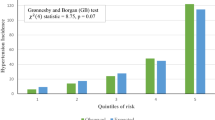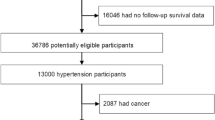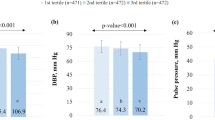Abstract
Few studies assessed incidence and determinants of hypertension. We assessed the incidence and determinants of hypertension in a cohort of healthy adults aged 35–75 years living in Lausanne, Switzerland. Baseline data were collected from 2003 to 2006. Follow-ups were conducted in 2009–2012 and 2014–2017. Incident hypertension, defined as a systolic BP ≥140 mm Hg or a diastolic BP ≥90 mm Hg or anti-hypertensive medication, was assessed at 1) second follow-up only; 2) first and/or second follow-up. After 10.9 years, incident hypertension was 26.8% (analysis 1, N = 3299) and 30.3% (analysis 2, N = 3728). After multivariate adjustment, the variables associated with increased hypertension incidence were male gender [incident-rate ratio (IRR) and (95% confidence interval)]: 1.20 (1.07–1.35) and 1.24 (1.13–1.37) for analyses 1 and 2, respectively; increasing age (p for trend < 0.001) and body mass index (p for trend < 0.001) and history of cardiovascular disease (CVD). Being physically active was negatively associated with incident hypertension: 0.88 (0.78–0.98) and 0.92 (0.83–1.01) for analyses 1 and 2, respectively. Except for male gender, these associations remained after adjusting for baseline BP levels, with incident rate ratios for physical activity of 0.86 (0.77–0.96) and 0.91 (0.83–0.99) for analyses 1 and 2, respectively. No association was found for education, alcohol consumption or smoking status. We conclude that over 10.9 years, between 1/4 and 1/3 of the Swiss population aged 35–75 developed hypertension. Male gender, history of CVD, increasing age and higher BMI increase the risk of hypertension, while being physically active reduces the risk.
This is a preview of subscription content, access via your institution
Access options
Subscribe to this journal
Receive 12 digital issues and online access to articles
$119.00 per year
only $9.92 per issue
Buy this article
- Purchase on Springer Link
- Instant access to full article PDF
Prices may be subject to local taxes which are calculated during checkout

Similar content being viewed by others
References
G. B. D. Risk Factors Collaborators. Global, regional, and national comparative risk assessment of 84 behavioural, environmental and occupational, and metabolic risks or clusters of risks, 1990-2016: a systematic analysis for the Global Burden of Disease Study 2016. Lancet. 2017;390:1345–422.
G. B. D. Risk Factors Collaborators. Global, regional, and national comparative risk assessment of 79 behavioural, environmental and occupational, and metabolic risks or clusters of risks, 1990–2015: a systematic analysis for the Global Burden of Disease Study 2015. Lancet. 2016;388:1659–724.
World health organization. A global brief on hypertension. Geneva, Switzerland: World health organization; 2013.
Authors/Task Force M, Piepoli MF, Hoes AW, Agewall S, Albus C, Brotons C, et al. 2016 European Guidelines on cardiovascular disease prevention in clinical practice: The Sixth Joint Task Force of the European Society of Cardiology and Other Societies on Cardiovascular Disease Prevention in Clinical Practice (constituted by representatives of 10 societies and by invited experts) Developed with the special contribution of the European Association for Cardiovascular Prevention & Rehabilitation (EACPR). Atherosclerosis. 2016;252:207–74.
Mancia G, Fagard R, Narkiewicz K, Redon J, Zanchetti A, Bohm M, et al. 2013 ESH/ESC Guidelines for the management of arterial hypertension: the Task Force for the management of arterial hypertension of the European Society of Hypertension (ESH) and of the European Society of Cardiology (ESC). J Hypertens. 2013;31:1281–357.
Thawornchaisit P, de Looze F, Reid CM, Seubsman SA, Sleigh AC, Thai Cohort Study T. Health risk factors and the incidence of hypertension: 4-year prospective findings from a national cohort of 60 569 Thai Open University students. BMJ Open. 2013;3:e002826.
Foerster M, Marques-Vidal P, Gmel G, Daeppen JB, Cornuz J, Hayoz D, et al. Alcohol drinking and cardiovascular risk in a population with high mean alcohol consumption. Am J Cardiol. 2009;103:361–8.
Juraschek SP, Blaha MJ, Whelton SP, Blumenthal R, Jones SR, Keteyian SJ, et al. Physical fitness and hypertension in a population at risk for cardiovascular disease: the Henry Ford ExercIse Testing (FIT) Project. J Am Heart Assoc. 2014;3:e001268.
Pereira M, Lunet N, Paulo C, Severo M, Azevedo A, Barros H. Incidence of hypertension in a prospective cohort study of adults from Porto, Portugal. BMC Cardiovasc Disord. 2012;12:114.
Firmann M, Mayor V, Vidal PM, Bochud M, Pecoud A, Hayoz D, et al. The CoLaus study: a population-based study to investigate the epidemiology and genetic determinants of cardiovascular risk factors and metabolic syndrome. BMC Cardiovasc Disord. 2008;8:6.
Knol MJ, Le Cessie S, Algra A, Vandenbroucke JP, Groenwold RH. Overestimation of risk ratios by odds ratios in trials and cohort studies: alternatives to logistic regression. Cmaj. 2012;184:895–9.
Oda E. Decreased serum albumin predicts hypertension in a Japanese health screening population. Intern Med. 2014;53:655–60.
Trudel X, Brisson C, Milot A, Masse B, Vezina M. Adverse psychosocial work factors, blood pressure and hypertension incidence: repeated exposure in a 5-year prospective cohort study. J Epidemiol Community Health. 2016;70:402–8.
Guillot M, Sforza E, Achour-Crawford E, Maudoux D, Saint-Martin M, Barthelemy JC, et al. Association between severe obstructive sleep apnea and incident arterial hypertension in the older people population. Sleep Med. 2013;14:838–42.
Narduzzi S, Golini MN, Porta D, Stafoggia M, Forastiere F. [Inverse probability weighting (IPW) for evaluating and “correcting” selection bias]. Epidemiol Prev. 2014;38:335–41.
Guessous I, Bochud M, Theler JM, Gaspoz JM, Pechere-Bertschi A. 1999–2009 Trends in prevalence, unawareness, treatment and control of hypertension in Geneva, Switzerland. PLoS ONE. 2012;7:e39877.
Walther D, Curjuric I, Dratva J, Schaffner E, Quinto C, Rochat T, et al. High blood pressure: prevalence and adherence to guidelines in a population-based cohort. Swiss Med Wkly. 2016;146:w14323.
Wang A, Liu X, Guo X, Dong Y, Wu Y, Huang Z. et al. Resting heart rate and risk of hypertension: results of the Kailuan cohort study. J Hypertens. 2014;32:1600–5.
Collaborators GBDO, Afshin A, Forouzanfar MH, Reitsma MB, Sur P, Estep K, et al. Health effects of overweight and obesity in 195 countries over 25 years. N Engl J Med. 2017;377:13–27.
Guerra F, Paccaud F, Marques-Vidal P. Trends in food availability in Switzerland, 1961–2007. Eur J Clin Nutr. 2012;66:273–5.
N. C. D. Risk Factor Collaboration. Worldwide trends in blood pressure from 1975 to 2015: a pooled analysis of 1479 population-based measurement studies with 19.1 million participants. Lancet. 2017;389:37–55.
Dubey RK, Oparil S, Imthurn B, Jackson EK. Sex hormones and hypertension. Cardiovasc Res. 2002;53:688–708.
Leblanc V, Hudon AM, Royer MM, Corneau L, Dodin S, Begin C, et al. Differences between men and women in dietary intakes and metabolic profile in response to a 12-week nutritional intervention promoting the Mediterranean diet. J Nutr Sci. 2015;4:e13.
Jani B, Rajkumar C. Ageing and vascular ageing. Postgrad Med J. 2006;82:357–62.
Weinstein JR, Anderson S. The aging kidney: physiological changes. Adv Chronic Kidney Dis. 2010;17:302–7.
Igarashi R, Fujihara K, Heianza Y, Ishizawa M, Kodama S, Saito K, et al. Impact of individual components and their combinations within a family history of hypertension on the incidence of hypertension: Toranomon hospital health management center study 22. Medicine (Baltim). 2016;95:e4564.
Westerdahl C, Li X, Sundquist J, Sundquist K, Zoller B. Family history as a predictor of hospitalization for hypertension in Sweden. J Hypertens. 2013;31:1952–8.
Liu C, Kraja AT, Smith JA, Brody JA, Franceschini N, Bis JC, et al. Meta-analysis identifies common and rare variants influencing blood pressure and overlapping with metabolic trait loci. Nat Genet. 2016;48:1162–70.
Tolonen H, Ahonen S, Jentoft S, Kuulasmaa K, Heldal J, European Health Examination Pilot P. Differences in participation rates and lessons learned about recruitment of participants--the European Health Examination Survey Pilot Project. Scand J Public Health. 2015;43:212–9.
Chappuis A, Bochud M, Glatz N, Vuistiner P, Paccaud F, Burnier M. Swiss survey on salt intake: main results. Lausanne, Switzerland: Department of Nephrology and Institute of Social and Preventive Medicine Lausanne University Hospital; 2011.
Chatelan A, Beer-Borst S, Randriamiharisoa A, Pasquier J, Blanco JM, Siegenthaler S, et al. Major differences in diet across three linguistic regions of Switzerland: results from the first national nutrition survey menuCH. Nutrients. 2017;9:E1163.
Acknowledgements
We would like to thank Dr. Vanessa Kraege for the reading and proofing of the manuscript.
Funding
The CoLaus study was and is supported by research grants from GlaxoSmithKline, the Faculty of Biology and Medicine of Lausanne, and the Swiss National Science Foundation (grants 33CSCO-122661, 33CS30-139468 and 33CS30-148401).
Author information
Authors and Affiliations
Corresponding author
Ethics declarations
Conflict of interest
The authors declare that they have no conflict of interest.
Electronic supplementary material
Rights and permissions
About this article
Cite this article
Fidalgo, A.S.Q., Vollenweider, P. & Marques-Vidal, P. Ten-year incidence of hypertension in a Swiss population-based sample Incidence of hypertension in Switzerland. J Hum Hypertens 33, 115–122 (2019). https://doi.org/10.1038/s41371-018-0116-4
Received:
Revised:
Accepted:
Published:
Issue Date:
DOI: https://doi.org/10.1038/s41371-018-0116-4



